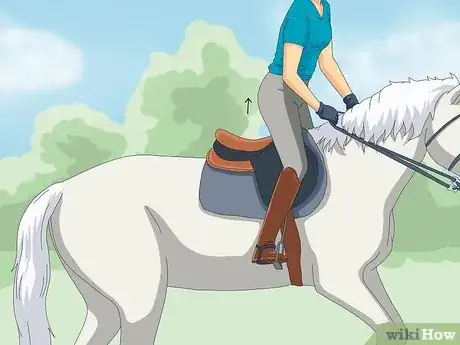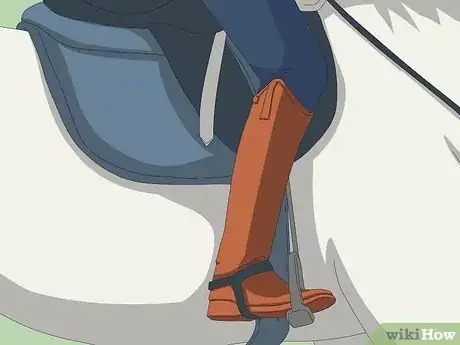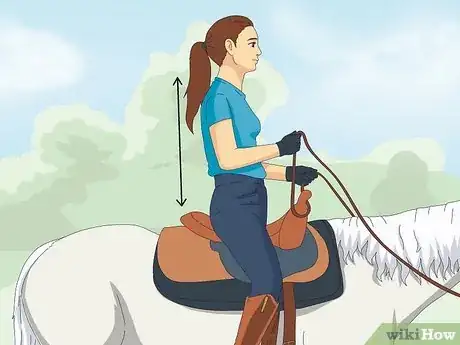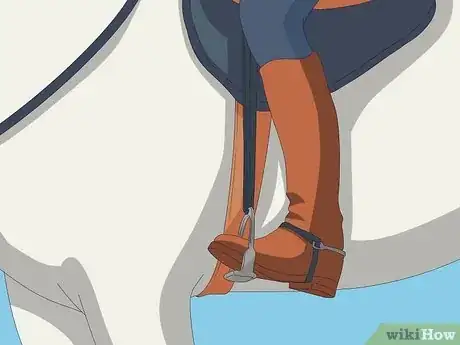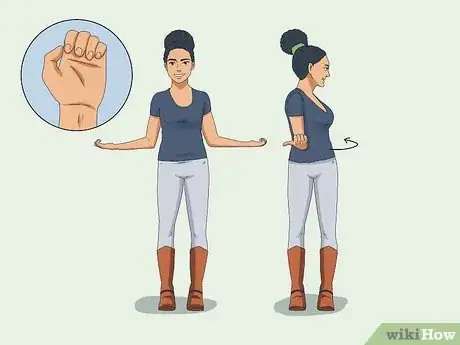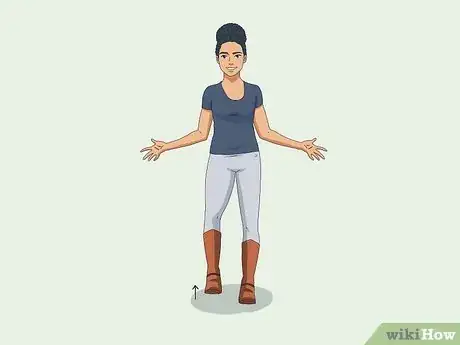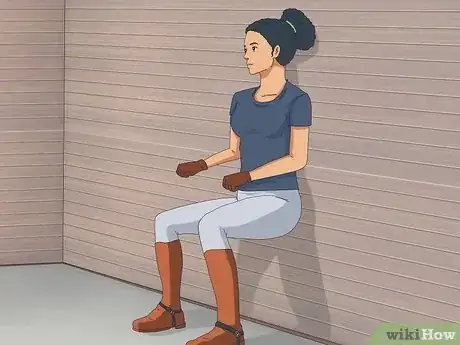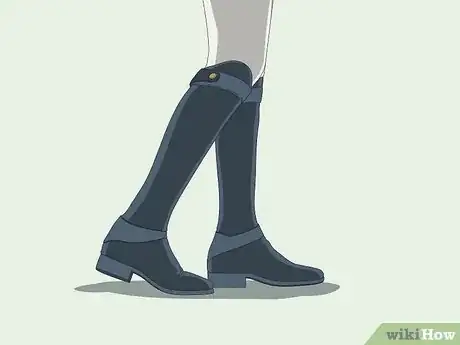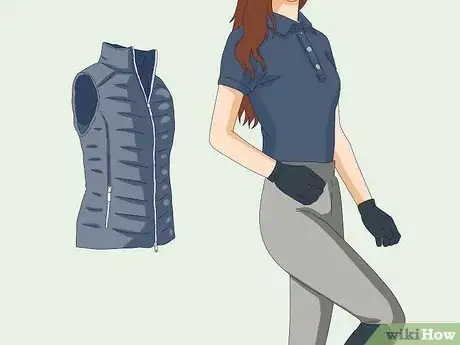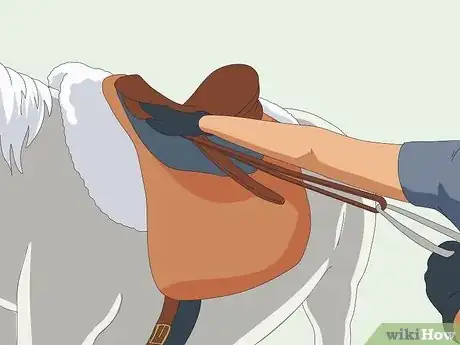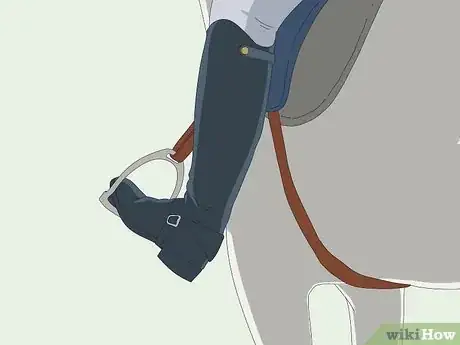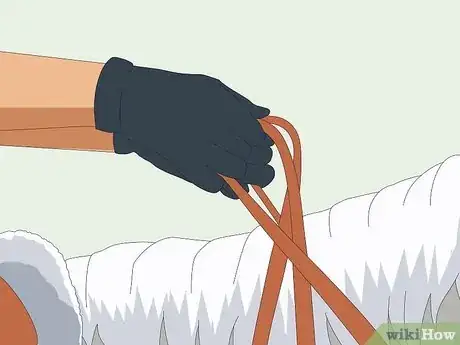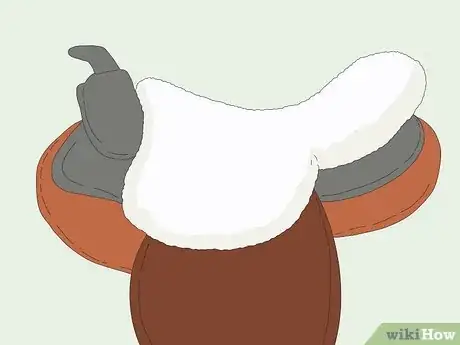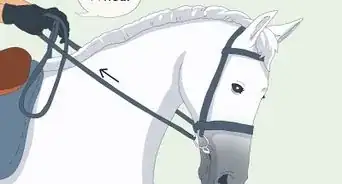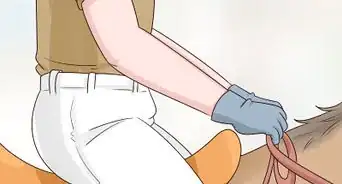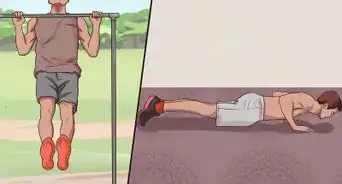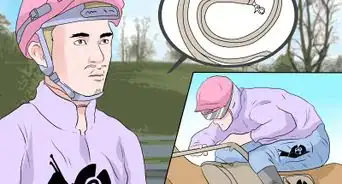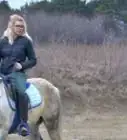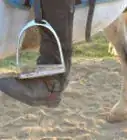This article was co-authored by Alana Silverman. Alana Silverman is a Certified EAGALA (Equine Assisted Growth and Learning Association) Equine Specialist and the Assistant Manager of Paddock Riding Club, a 200-horse premier equestrian facility based in Los Angeles, California. Alana has over 25 years of experience caring for and riding horses and specializes in English riding and riding instruction. She has a BA in Psychology from the University of Arizona.
There are 7 references cited in this article, which can be found at the bottom of the page.
This article has been viewed 57,008 times.
There’s no way around it: horse-riding definitely jostles you around. This can leave you sore and strained afterward, especially if you are a beginner who is still getting used to it. Choosing the right equipment and clothing can definitely help minimize sore spots. But even more important is riding with proper posture and maintaining strong core muscles. These will help you stay relaxed and fluid as you ride so you don’t tense up and strain yourself.
Steps
Maintaining Good Posture
-
1Ride as though you’re standing up, not sitting. Imagine that the horse suddenly winks out of existence from underneath you. Ride so that you would immediately land on your feet in a standing position if this were to happen. Ask a spotter to watch you ride and correct your posture as you go. Aim to maintain an unbroken line from your ear, through your shoulder and hip, and all the way down to your heel when viewed from the side.[1]
- Although this form is considered ideal, the exception would be if you need to adjust your stirrups to alleviate strain in your knees.
-
2Hug the horse with your legs. Although the horse’s body will force your upper legs to stick out to your sides, resist the urge to follow through with your lower legs. Don’t stick your whole leg out to the side. Keep your lower legs close enough to the horse’s body to maintain contact.[2]
- Ask a spotter to watch you as you ride straight toward them. Have them alert you whenever you start to straighten your legs to the side.
- Exerting pressure downward into the stirrups and out to your sides can lead to ankle and knee pain.
Advertisement -
3Avoid arching your back. Sit up straight to keep a straight line running from ear to shoulder to hip. However, be careful not to overdo it by arching backward. Stay seated on the seat-bones on your butt.[3]
- Arching your back causes your weight to shift forward, which means you’ll be landing on your tender bits instead of the bones in your butt as you bounce in the saddle.
- Being able to sit up straight without having to think about it is an important reason to strengthen your core both on and off the horse. This will prevent you from tensing up as you try to maintain posture.
- In the meantime, focus on drawing your bellybutton in toward your spine. Concentrate only on the muscles required for this. This will help keep your back relaxed as you ride.
-
4Point your toes slightly outward. Disregard outdated instructions about pointing your toes straight ahead of you. Avoid the unnecessary stress that this places on your joints. Instead, angle your feet so that each is pointing away from the horse by just a smidge. As you do, keep the balls of your feet in the stirrup. Stop when the weight of each foot feels evenly distributed across the entire stirrup.
- This may be referred to as “pronating” by instructors.
- It's always best to wear boots with a small heel, so your feet can stay steady in the stirrups.[4]
Strengthening Your Core
-
1Tuck, twist, turn. To start, stand up with your feet placed under your hips. Curl your fingers into loose fists with your thumbs sticking out. Keep your upper arms and elbows tucked to your sides. Raise your forearms to either side of you, with your palms facing up and your thumbs pointing behind you. Then:[5]
- Bend your knees a little bit while tucking your tailbone inward.
- Keeping your feet in place, turn your upper torso to one side, twisting from your waist.
- Stop once your rear arm is pointed directly behind your butt.
- Twist back to your original position, again using the muscles in your waist.
- Perform the same movements on your other side for one rep.
-
2Balance your core. To begin, stand with your feet placed a hand’s length apart.[6] Keeping your upper arms and elbow tucked to your sides, raise your forearms straight out to either side with your palms facing in front of you. Spread your fingers wide to keep the muscles in your hands, arms, and back active (think “jazz hands”). Next:[7]
- Raise one foot slightly off the ground.
- Keep your other leg’s knee slightly bent to better absorb your body weight.
- Rotate your raised foot until your toes point inward.
- Focus on your heel as it directs each movement, not your toes.
- Lower your foot and repeat the exercise with your other foot.
- Concentrate on your heels throughout to keep your core muscles engaged.
-
3Clap your hands.[8] Get into position by standing back against a wall. Set your feet a hand’s length apart.[9] Bend your knees as you do so your entire back makes contact with the wall. Tuck your upper arms and elbows into your side. Raise your forearms straight out to either side. Now:[10]
- Sweep your forearms in toward each to clap your hands in front of you.
- As you do, keep your forearms perpendicular to your body.
- Once your hands have clapped, fold your fingers with your thumbs on top to mimic holding a rein.
- Bring your forearms back to starting position and repeat.
Gearing Up
-
1Wear the right boots. Make sure they are tall enough to cover your ankles, which will keep them supported as you ride. Opt for a heel between 1 and 1 ½ inches to prevent your feet from spilling out of the stirrups.[11] At the same time, avoid boots with heavy treads, which may cause your feet to become stuck in the stirrups, preventing a quick dismount in an emergency. Do not wear the following:[12]
- Waffle treads
- Thick treads
- Hiking boots
- Winter boots
- Sneakers[13]
- Sandals and flip-flops
-
2Choose flexible clothing. For upstairs, stick to sweatshirts and T-shirts so your arms and upper torso aren’t restricted. In colder weather, opt for layers topped with a vest to keep your arms mobile. Downstairs, favor tights, jeans, and sweatpants. Be sure that they are flexible enough to allow your legs to move freely.[14]
- Although you want your clothes to allow you freedom of movement, they should still be form-fitting or close to it. Loose clothing may become caught on your equipment or surroundings, which can lead to injury.
- Don’t wear pants that easily become twisted or bunched up as you move in them.
- Don't wear shorts when you go riding, or else your legs will chafe and hurt a lot.[15]
-
3Adjust your stirrups’ length. If your knees feel strained as you ride, play with the length to find one that helps alleviate the pain. Length is a matter of personal preference, so don’t feel obligated to copy a more experienced rider if their preferred length causes you pain. As you shorten and lengthen your stirrups, remember:[16]
- You want to find a leg position that allows your legs to comfortably exert enough force into the stirrups to raise your butt a little. This prevents you from sitting with all of your body weight on the saddle, which will make your butt sore.
- Try placing your stirrup so your knees are bent at about a 45°angle for a comfortable fit.[17]
- If your stirrups are too short, your knees will be too bent, which can cause some knee pain. If the stirrups are too long, your legs are too straight, and that will also put strain on your legs.[18]
-
4Use a saddle whose stirrups swing freely. Whenever you go downhill, let your feet follow gravity. Straighten your legs in a forward direction as you descend. Do this to lessen the amount of pressure that your knees have to bear.[19]
-
5Use light reins. Expect your hands to grow numb or sore from having to hold the reins over the course of long rides. If possible, avoid using a thick rein made of rope. Instead, use a thinner rein made of leather, which is usually lighter and less taxing in the long run.[22]
- Also, wear gloves to prevent blisters.
-
6Sit on a “seat saver.” Soften the blows that your butt has to endure from sitting on a hard saddle. Cover the saddle with a seat saver whose cushioning absorbs most of the shock before it reaches your rear. Store your seat saver somewhere warm and dry after your ride.[23]
- Keep in mind that some seat savers’ material (especially foam) may act like a sponge if it gets wet. This means it will become just as hard as your saddle if temperatures dip below freezing.
Expert Q&A
Did you know you can get expert answers for this article?
Unlock expert answers by supporting wikiHow
-
QuestionHow can I make my legs less sore after a ride?
 Jessica RudeJessica Rude is an Equine Expert currently working on a cutting horse ranch in Valley View, Texas as well as a horseback riding center in Princeton, Texas. Previously, she was a Trail Guide and Wrangler at a camp and retreat center In Dallas, Texas, and an Equine Breeding Barn Manager at a reining ranch in Tioga, Texas. Jessica holds a Bachelor’s degree in Animal Science with an emphasis in Equine Science from Tarleton State University. She has studied equine nutrition, reproduction, and management. Jessica specializes in equine breeding as well as instructing horseback riding lessons, leading trail rides, recognizing equine illnesses, and administering treatments.
Jessica RudeJessica Rude is an Equine Expert currently working on a cutting horse ranch in Valley View, Texas as well as a horseback riding center in Princeton, Texas. Previously, she was a Trail Guide and Wrangler at a camp and retreat center In Dallas, Texas, and an Equine Breeding Barn Manager at a reining ranch in Tioga, Texas. Jessica holds a Bachelor’s degree in Animal Science with an emphasis in Equine Science from Tarleton State University. She has studied equine nutrition, reproduction, and management. Jessica specializes in equine breeding as well as instructing horseback riding lessons, leading trail rides, recognizing equine illnesses, and administering treatments.
Equine Expert Make sure your stirrup length is the right fit for you. It's typically most comfortable if your knees are bent at about a 45° angle, so your foot stays flat instead of pointed down. If the stirrups are too short, your knees will be bent too much, and your knees will hurt after a ride. If your stirrups are too long, your legs will be straight, which will also put strain on them.
Make sure your stirrup length is the right fit for you. It's typically most comfortable if your knees are bent at about a 45° angle, so your foot stays flat instead of pointed down. If the stirrups are too short, your knees will be bent too much, and your knees will hurt after a ride. If your stirrups are too long, your legs will be straight, which will also put strain on them. -
QuestionMy legs and thighs are in pain and I have a horseback riding lesson soon. What should I do?
 Community AnswerThere is really no way to stop the soreness completely, but after a few weeks, your legs and thighs shouldn't hurt, because horse riding uses different muscles you never knew you had. You will notice you gain muscles in your thighs more. Do some exercises to strengthen yourself more. When I was in pain from riding, I just kept moving, and running, and jumping, and eventually, it will wear off after a day or two, depending on how much you exercise.
Community AnswerThere is really no way to stop the soreness completely, but after a few weeks, your legs and thighs shouldn't hurt, because horse riding uses different muscles you never knew you had. You will notice you gain muscles in your thighs more. Do some exercises to strengthen yourself more. When I was in pain from riding, I just kept moving, and running, and jumping, and eventually, it will wear off after a day or two, depending on how much you exercise. -
QuestionHow do I get rid of pain after falling?
 Community AnswerFirst, ice the area and take some painkillers if you need to. Keep the injured area rested for a few days. If the pain persists, see a doctor.
Community AnswerFirst, ice the area and take some painkillers if you need to. Keep the injured area rested for a few days. If the pain persists, see a doctor.
Warnings
- If you're in pain, always alert your instructor for advice. If the pain does not improve or worsens, always speak with your doctor.⧼thumbs_response⧽
References
- ↑ http://trailridermag.com/article/riding-perfect-position-15651
- ↑ http://trailridermag.com/article/riding-perfect-position-15651
- ↑ http://trailridermag.com/article/riding-perfect-position-15651
- ↑ Alana Silverman. Certified EAGALA Equine Specialist. Expert Interview. 17 March 2020.
- ↑ http://www.horsechannel.com/horse-community/exercises-for-equestrians.aspx
- ↑ http://www.horsechannel.com/horse-community/ride-without-pain.aspx
- ↑ http://www.horsechannel.com/horse-community/exercises-for-equestrians.aspx
- ↑ http://www.horsechannel.com/horse-community/exercises-for-equestrians.aspx
- ↑ http://www.horsechannel.com/horse-community/ride-without-pain.aspx
- ↑ http://www.horsechannel.com/horse-community/exercises-for-equestrians.aspx
- ↑ Alana Silverman. Certified EAGALA Equine Specialist. Expert Interview. 17 March 2020.
- ↑ http://www.myhorseuniversity.com/resources/EE/July2012/EquestrianAttire
- ↑ Alana Silverman. Certified EAGALA Equine Specialist. Expert Interview. 17 March 2020.
- ↑ http://www.myhorseuniversity.com/resources/EE/July2012/EquestrianAttire
- ↑ Alana Silverman. Certified EAGALA Equine Specialist. Expert Interview. 17 March 2020.
- ↑ http://trailridermag.com/article/saddle-sore-23543
- ↑ Jessica Rude. Equine Expert. Expert Interview. 18 September 2020.
- ↑ Jessica Rude. Equine Expert. Expert Interview. 18 September 2020.
- ↑ http://trailridermag.com/article/saddle-sore-23543
- ↑ http://trailridermag.com/article/riding-perfect-position-15651
- ↑ Jessica Rude. Equine Expert. Expert Interview. 18 September 2020.
- ↑ http://trailridermag.com/article/saddle-sore-23543
- ↑ http://trailridermag.com/article/saddle-sore-23543
- ↑ Jessica Rude. Equine Expert. Expert Interview. 18 September 2020.
About This Article
To avoid soreness during your horse-riding training, start by using thin, light reins made of leather to prevent achy hands and fingers. You can also cushion your backside by covering your saddle with a seat saver. When you're riding, remember to hug the horse with your knees, keep your toes pointed slightly outward, and maintain good posture to prevent soreness the next day. Focus on drawing your bellybutton in toward your spine to help strengthen your core and keep your back relaxed as you ride. For more tips on strengthening your core, read on!
